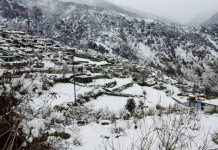
Maarisami, a 51-year-old Salem (Tamil Nadu) resident, had been visiting the Sabarimala temple in Kerala for the past nine years. All these years, after visiting the temple he would go down the hill to have a dip in the holy river Pampa before returning home.
He believes that a dip in the river would free him from all sins. After the bath, he would throw away all his old clothes in the river in the belief that it would help him start life afresh. He thought that dumping clothes into the river is part of a religious ritual until a 16-year-old boy told him that this year it is against the customs and rituals of Sabarimala. Moreover, the discarded clothes are clogging the river flow, threatening its marine ecosystem and polluting the river on a large scale.
This tale was narrated by Melvin Benny, a class XI student of a Pathanamthitta school. He was one of the few volunteers posted by the district administration (Pathanamthitta) to spread the message of ‘Mission Green Sabarimala’ to keep the river clean.
The mission started by the district administration with the help of Travancore Devaswom Board (TDB), Kerala Suchitwa Mission, Kudumbasree self-help groups and other private agencies, has elicited a good response.
District collector of Pathanamthitta, S Harikishore tells Tehelka that it was a mission in continuation with ‘Plastic Free Sabarimala’, a successful project in reducing plastic wastes in Sabarimala initiated last year. “With these missions, we aim to reduce the volume of plastic waste in Sabarimala and keep Pampa clean. Every year around 100 million pilgrims visit the hill shrine. With such a huge number of people visiting the temple in a limited period it was difficult for us to create awareness among the pilgrims about the hazards of plastic waste. Therefore, we sought the help of various departments to implement the mission — for spreading awareness and distributing cloth bags instead of plastic bags. With sustained efforts, we were able to bring down the volume of plastic waste in Sabarimala this year and keep the Pampa river clean,” says Harikishore.
As per the official estimate, each pilgrim who goes to the hill shrine leaves behind at least 250 grams of plastic. Last year alone, 8,750 tonnes of plastic; including water bottles, food wrappers, use-and-throw raincoats and plastic carry bags; were dumped in the area. The 1,500-year-old temple, which is surrounded by the flora and fauna of the Periyar Wildlife Sanctuary, faces a major environmental threat. Last year, traces of plastic were found in the digestive tracts of a dead elephant and a sambar deer. This prompted the forest department to explore ways to ban disposable items here.
“According to the primary data available, the plastic waste in Sabarimala has come down drastically this year. Last year 20 truckloads of plastic waste were removed and this season only three,” says Harikishore.
Moreover, various campaigns with the help of forest department, Suchitwa Mission, and Kudumbasree have taken place this year. Almost all communication channels were used to cover all trekking paths and roads. A campaign whereby vehicles of pilgrims going to Sabarimala were stopped at checkpoints to give cloth bags in return for their plastic bags was a great success. Women selfhelp group members from around 54 panchayats in the district were present all through the pilgrim season to collect plastic waste and distribute cloth bags to the pilgrims.










